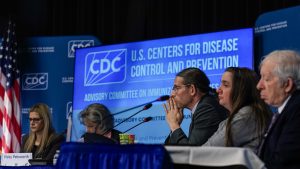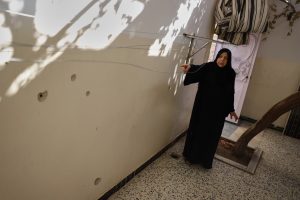WHO members approve landmark draft proposal to combat future pandemics
Ella Greene April 16, 2025 0
- World Health Organization (WHO) members agreed on Wednesday to a submit a draft proposal tackling future pandemics to the World Health Assembly in May. The agreement includes measures on the global sharing of vaccines, drugs and technology among the dozens of nations that are members of the global health agency.
- The U.S. walked away from the negotiations after President Donald Trump began the 12-month process of withdrawing the United States from the WHO in January.
- If member states adopt and ratify the draft, the pact will not impact the United States.
Full Story
After more than three years of talks, World Health Organization (WHO) member states announced a major breakthrough in tackling future pandemics while striving to avoid errors made in dealing with the COVID-19 pandemic, which led to the deaths of millions of people worldwide.
Member states drafted a proposal on Wednesday, April 16, and will bring it to the World Health Assembly in May as it moves closer to potential implementation.
What is the WHO saying?
The WHO said in a statement on Wednesday, the draft’s goal is to enhance global coordination on preventing, preparing for and combating future pandemics.
“In December 2021, at the height of the COVID-19 pandemic, WHO Member States established the Intergovernmental Negotiating Body (INB) to draft and negotiate a convention, agreement or other international instrument, under the WHO Constitution, to strengthen pandemic prevention, preparedness and response.”
The WHO said following more than a dozen rounds of meetings and other negotiations, the INB “finalized a proposal for the WHO Pandemic Agreement.”
How will the agreement work?
Agreements within the proposal include the fair disbursement of drugs and vaccines between wealthy nations and impoverished countries. The proposal also aims to alleviate inequities in health care systems across nations regarding how they develop and distribute vaccines, medicines and health equipment.
For instance, there is a requirement for participating governments to implement national policies to create the framework to guarantee pandemic-related medicines and vaccines are accessible worldwide, which marks a first for a global health pact.
Other requirements include allowing the WHO to access and oversee world supply chains of medical equipment like masks and vaccines. It also allows for more domestic production of vaccines and treatments during a health crisis through this sharing of information.
The potential pact would also mandate participating drug-makers to set aside 20% of “their real-time production of vaccines,” treatments and analytics to the WHO during a global pandemic. The WHO said they would reserve a minimum of 10% of this technology for donations while delivering the rest at affordable prices, according to Reuters.
What held up negotiations?
Negotiations were held up by this measure, as hours were reportedly dedicated to debating the sharing of technology capabilities and manufacturing capacity in an effort to aid lower income nations in the production of vaccines, treatments and methodology.
“The deal essentially gives WHO members more teeth in terms of their preparedness, response and prevention of future pandemics,” the policy engagement advisor with the Governing Pandemics Team at the Global Health Centre, told Reuters.
Which problems does the agreement potentially fix?
The new requirements come as wealthy nations were accused during the COVID-19 Pandemic of hoarding vaccines, tests and Personal Protective Equipment (PPE), leaving other countries without access to vital treatment and protection.
Reuters reported, this is the second time in the global health agency’s 75-year existence that member nations have agreed to a binding pact since a “tobacco accord in 2003.”
Who is celebrating the agreement?
The global health agency celebrated the initial agreement, which next seeks to become a legally binding agreement.
In a statement, the WHO said, “After more than three years of intensive negotiations, WHO member states took a major step forward in efforts to make the world safer from pandemics.”
What about the United States?
The landmark agreement comes as the United States, the organization’s largest funder, walked away from the organization and implemented cuts to foreign aid while threatening tariffs on pharmaceuticals, which undoubtedly loomed over the negotiations.
U.S. officials reportedly left the negotiations after President Donald Trump initiated a year-long process of pulling the United States out of the global health agency.
If member states adopt the draft proposal, the pact will not impact the United States.
“This is a historic moment and a show that with or without the U.S., countries are committed to working together and to the power of multilateralism,” the founder of the global health think tank Spark Street Advisors, Nina Schwalbe, told Reuters.
What happens next?
The proposal must still go through the adoption process in May at the World Health Assembly and will have to be ratified by member states after that.
Health officials said they are optimistic the agreement will inspire more investment in tackling future health emergencies amid slashes to global health funding.
Related Stories
Ella Rae Greene, Editor In Chief
Ella Greene
Ella and the staff at Clear Media Project (CMP) curate these articles.
Unless otherwise noted CMP does not write these articles.
The views, thoughts, and opinions expressed in the articles published on this blog belong solely to the original authors and do not necessarily reflect the views of the blog owner. The blog owner does not claim ownership of the content shared by contributors and is not responsible for any inaccuracies, errors, or omissions.
All rights and credits goes to its rightful owners. No Copyright Infringement is intended. If you believe any content infringes on your rights, please contact us for review and potential removal.





